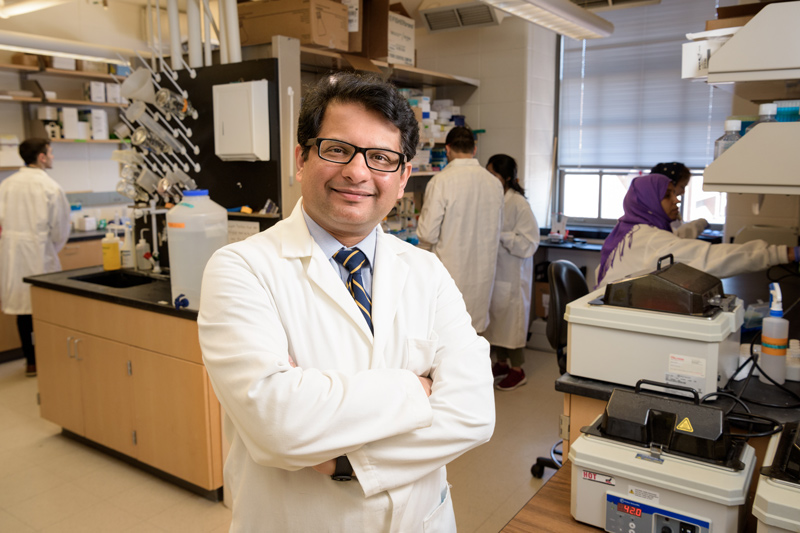


Insights into cataracts
Photo by Evan Krape July 22, 2021
Large genetic study identifies dozens of new links to eye disease
Researchers at the University of Delaware, working with colleagues at the Kaiser Permanente Division of Research and 23andMe Inc., have found 54 locations on the human genome that are associated with the risk of age-related cataracts, the leading cause of blindness worldwide.
The research, published June 14 in the journal Nature Communications, represents the largest and most ethnically diverse genetic study of cataracts. Scientists looked at genetic information from more than 3.8 million people — obtained from the Kaiser Permanente Northern California health care system, UK Biobank in the United Kingdom and the genetic testing company 23andMe — all of whom volunteered their genetic and medical information for research.
The study identifies new locations on the genome that could relate to an increased risk of cataracts, including one location that seems to be specific to women, who develop the condition more often than men. That finding especially “highlights the need to include sex as a biological variable in future studies,” said Salil Lachke, Alumni Distinguished Early Career Professor of Biology and associate chair of the Department of Biological Sciences at UD, the joint senior author of the paper, which was also co-authored by UD postdoctoral researcher Deepti Anand.
“There are so many aspects to this multi-ethnic study that are important,” Lachke said. “It represents a critical first step toward addressing this very significant human eye disease associated with aging … and makes a case for inclusion and diversity in these studies.”
Lead author Hélène Choquet, a research scientist at the Kaiser Permanente Division of Research, said that identifying individuals who are at higher risk of developing cataracts could lead to earlier treatments and possible lifestyle changes to reduce their risk. Cataracts, defined as clouding of the lens of the eye, generally develop with age, but such factors as smoking and certain medications can increase the risk.
About half of Americans age 80 or older are impacted by cataracts, according to the National Eye Institute. Currently, the only treatment for cataracts is surgery, which is estimated to cost $3.4 billion annually and is projected to increase over the next 25 years as the U.S. population ages. For those reasons, understanding the genetic, biological and environmental basis of the disease remains critical, the researchers said.
“This [study] is the first step, and we can use this information along with other factors to build predictive models to identify people more likely to develop cataracts,” Choquet said. “If we can screen people before they develop a disease, that would help them and their doctors be vigilant to rapidly identify when a cataract is forming or perhaps help them make lifestyle changes.”
Choquet and colleagues conducted the population-genetics research, identifying the 54 locations associated with the risk of cataracts. After analyzing the genetic data, a separate database, developed at UD by Lachke, was used to confirm the results, finding that many of the genes at the newly discovered locations were abundantly present in the lens. Their levels were also found to be affected in other models of cataract, suggesting their importance in ensuring a healthy lens tissue.
“Finding the [genetic] locations is the first step,” Lachke said. “But it is critical to also find the biological connections to understand the basis of the pathology of the disease.”
The database used for that part of the research is known as Integrated Systems Tool for Eye gene discovery (iSyTE), a bioinformatics-based tool that predicts the genes associated with eye development and defects. The interactive tool is available to all clinicians, scientists and anyone who is interested in studying eye development and disorders, Lachke said. His own work as a developmental biologist focuses on interdisciplinary genetic research involving the eye and its associated defects, including a particular interest in pediatric cataracts.
Over the past decade, iSyTE has led to the identification of several new genes and regulatory pathways linked to pediatric cataract, but this is the first time the database was successfully applied in the study of genes associated with age-related cataract. Lachke said his laboratory has “invested considerable effort in updating and expanding iSyTE by including gene expression data using different technologies and on different stages of the lens,” which allowed it to be used successfully in the new study.
“The use of iSyTE to show gene expression was an important part of the new study,” Choquet said. “If a gene is expressed in the tissue, that means its perturbations could have a direct relationship to the development of a cataract.”
These findings have initiated a long-term collaboration between Choquet and Lachke, who are applying for grants to support future work in understanding the mechanisms of how genetic changes affect susceptibility to cataracts.
More about this study
The study was funded by several grants from the National Institutes of Health, particularly the National Eye Institute.
The paper was authored by researchers from the University of California San Francisco and King’s College London, in addition to those from Kaiser Permanente Northern California, UD and the 23andMe Research Team.
Genetic data was examined for association with cataract risk in 67,844 people with cataract and 517,399 people without cataract from the Kaiser Permanente Research Bank and UK Biobank. Those findings were then replicated using data from 347,209 people with cataract and more than 2.8 million without cataract from the 23andMe research cohort.
This article includes information from the Kaiser Permanente Division of Research.
Contact Us
Have a UDaily story idea?
Contact us at ocm@udel.edu
Members of the press
Contact us at 302-831-NEWS or visit the Media Relations website

